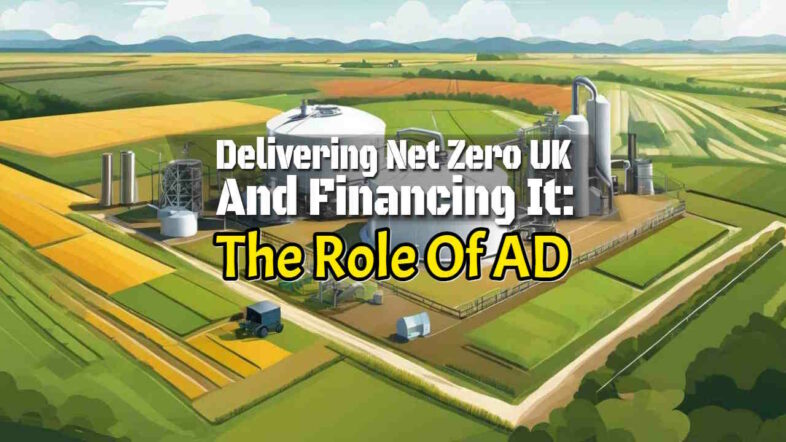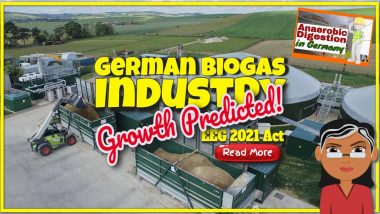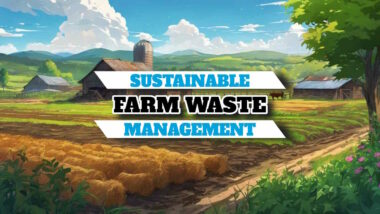In this article, we will focus on delivering Net Zero UK in transport, heat, agriculture and waste management and crucially also finding the money for it. Read on, and find out about the importance of anaerobic digestion, biogas, and biomethane in achieving net zero in the United Kingdom and how funding it may be achieved.
Welcome to our talk about how the UK can have zero carbon emissions and pay for it with things like digesting waste without oxygen, biogas, and biomethane. It is all about how the UK will stop burning harmful gases by changing how we deal with rubbish, grow food, keep homes warm, and move around.
The anaerobic digestion process which is essentially just breaking down waste without air can be a big help in cutting down the UK's climate-changing gas emissions (greenhouse gas emissions).
Using biogas can help clean our air and achieve national targets set to limit climate change to a 1.5° rise. In the UK existing and planned capacity will be doing this in a way that will be reducing the UK's greenhouse gas emissions by 6% soon.
Developing the UK biogas industry to its full potential would also create 60,000 new jobs that are good for our planet. The growth in the UK's anaerobic digestion capacity will soon equal the nation's nuclear power generation at substantially less cost.
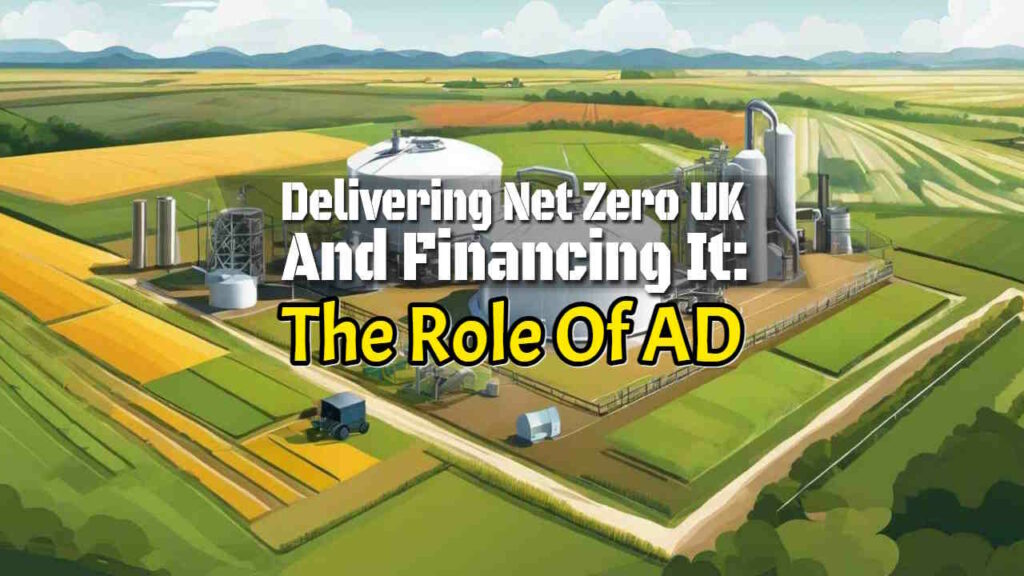
Key Takeaways
- Anaerobic digestion (AD) turns waste into clean energy, stopping harmful methane from polluting the air. It helps the UK cut carbon by powering cars and heating buildings with biogas or biomethane instead of fossil fuels.
- The AD industry could help reduce the UK's greenhouse gases by 6% in ten years and create 60,000 new green jobs, aiding the Green Recovery after Covid-19.
- Funding is key for AD growth. Sources include:
- Scottish Investment Bank's Renewable Energy Investment Fund,
- Defra's Rural Community Energy Fund,
- Innovate UK grants, and
- Government strategies like the Green Finance Strategy.
- In England, by 2026 there will be new rules about food waste meaning that it will by then be fully collected every week from all English homes, institutions, and businesses.
- The UK government wants a Net Zero country by 2050 through laws like the Climate Change Act. They plan to give money for renewable energy projects and create jobs that are good for our planet.
[boomdevs_toc]
Achieving Net Zero 2050 UK
ADBA the London-based trade body for the anaerobic digestion and biogas industry foresees the UK achieving “net zero UK” by focusing on delivering in:
- transport,
- heat,
- agriculture, and
- waste management.
A range of financial structures, explained in detail below, will grow to support AD in the Green Recovery. They can be implemented, and this will demonstrate the value of AD in the help that AD technology is achieving toward complying with the Paris Agreement targets for net-zero UK greenhouse gas emissions by 2050.
Focus on delivering Net Zero in transport, heat, agriculture, and waste management
To reach Net Zero, we must change how we travel, warm our buildings, grow food, and handle waste. Cars and buses can switch to biomethane instead of petrol or diesel. This clean gas comes from anaerobic digestion and helps us cut carbon emissions.
In homes and offices, we need to stop using fossil fuels for heating. Anaerobic digestion makes biogas that can heat these places without adding more carbon to the air.
Farms have to work differently too. They can use waste products better. These wastes turn into energy through anaerobic digestion, which helps stop methane from entering the atmosphere.
It's also essential for how we manage rubbish – turning food scraps into energy is smarter than letting them rot in a landfill where they release harmful gases.
Financial structures support AD in the Green Recovery
The United Kingdom's ambitious Net Zero goals (referred to as “net zero UK”) hinge significantly on the strategic mobilization of financial resources, particularly in sectors like biogas and biomethane.
This necessity was a focal point at the ADBA National Conference 2021, where experts convened to discuss the intricacies of funnelling low-interest investment into these crucial areas.
Securing this investment is more than just an economic manoeuvre; it's a vital step towards a sustainable future. With judicious financial planning and allocation, the AD sector can substantially contribute to reducing the UK's greenhouse gas emissions – by an estimated 6% over the next decade.
This is not just about meeting environmental targets; it's also about fostering economic growth.
The expansion of the AD sector, fueled by these investments, is projected to generate around 60,000 new jobs, offering not just employment but roles that actively contribute to environmental preservation.
In essence, the key takeaway from the ADBA National Conference 2021 is clear: substantial and well-directed investment in the biogas and biomethane sectors is indispensable but with the help of these bodies net zero UK is feasible in time to meet the government's target dates.
To achieve the ambitious goal of reaching net zero carbon emissions by 2050, the United Kingdom is strategically positioning itself to leverage a variety of financial instruments and funding mechanisms.
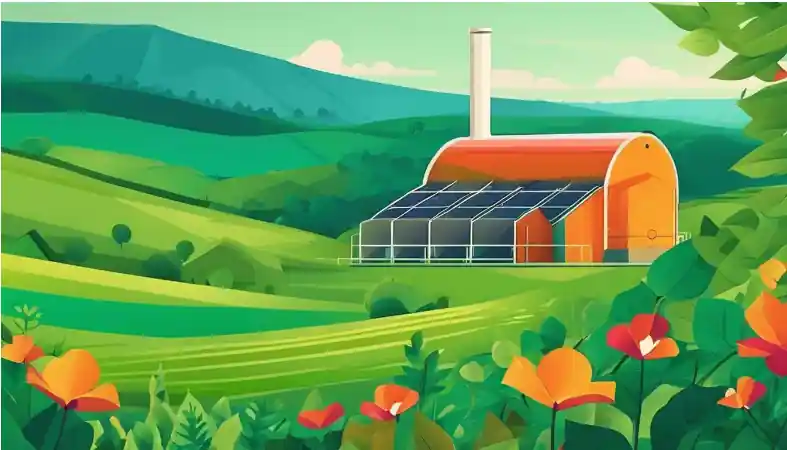
In the next section we explain what these are:
Green Banks and Green Finance Bodies
Green Banks
“Green” banks, are specialized financial institutions focused on supporting environmentally sustainable projects. These banks will play a pivotal role in channelling capital towards initiatives that reduce carbon emissions and promote renewable energy sources.
Furthermore, the UK government's commitment is evident through its provision of grants and subsidies aimed at fostering a more sustainable economy.
Purpose of Green Finance Bodies:
Green finance bodies are specialized organizations or entities focused on supporting environmental sustainability through financial means.
Their primary objectives revolve around mobilizing and channelling capital to projects and initiatives that have a positive environmental impact.
These bodies operate within various sectors, including government, private finance, and non-governmental organizations. They aim to integrate environmental considerations into financial decision-making, thereby promoting sustainable development.
The following is a comprehensive list of green finance bodies active in the UK, along with details about the types of renewable energy projects they support providing links to their websites:
List of Green Finance Bodies in the UK
- UK Green Investment Bank
- Focus: Primarily invests in offshore wind projects, energy efficiency, and waste and bioenergy sectors.
- Website: UK Green Investment Bank
- Carbon Trust
- Focus: Offers support for low-carbon technologies, including solar, wind, and marine energy.
- Website: Carbon Trust
- Clean Growth Fund
- Focus: Invests in early-stage clean growth ventures, including renewable energy technologies like solar and wind power.
- Website: Clean Growth Fund
- Triodos Bank
- Focus: Financing for a range of sustainable energy projects, including wind, solar, and hydropower.
- Website: Triodos Bank
- The Renewable Energy Association (REA)
- Focus: Supports a wide range of renewable energy sources, including bioenergy, solar, wind, and hydro.
- Website: REA
- Energy Saving Trust
- Focus: Provides funding for energy efficiency and renewable energy projects, including solar, wind, and biomass.
- Website: Energy Saving Trust
- British Renewable Energy Awards
- Focus: While not a funding body per se, they recognize and incentivize various renewable energy projects.
- Website: British Renewable Energy Awards
- Green Finance Institute
- Focus: Aims to finance the transition to a sustainable, low-carbon economy, supporting various renewable energy projects.
- Website: Green Finance Institute
- Low Carbon Contracts Company
- Focus: Manages contracts for difference, which help fund various renewable energy projects like wind, solar, and tidal.
- Website: LCCC
- Environmental Finance
- Focus: Provides information and services related to environmental finance, including renewable energy investments.
- Website: Environmental Finance
In summary, green banks with access to high-risk government-seeding grants and green finance bodies will be instrumental in driving the transition towards a more sustainable and environmentally friendly global economy.
By mobilizing capital, developing innovative financial tools, promoting sustainable investment practices, advocating for supportive policies, and raising awareness, they will play a pivotal role in combating climate change and supporting environmental conservation.
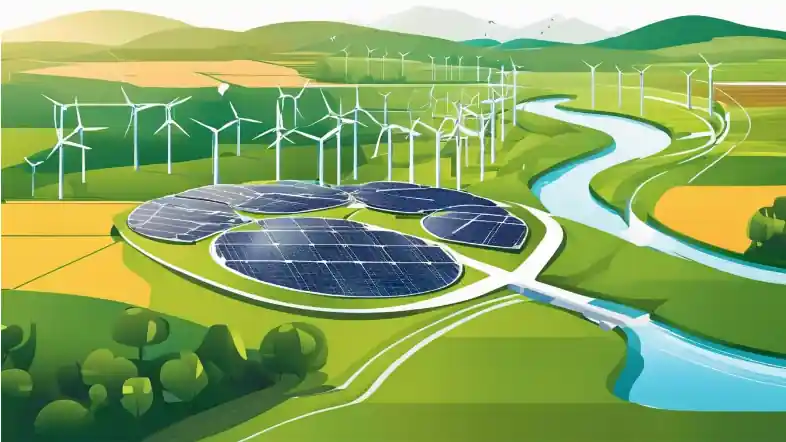
Green Funding Case Studies and Success Stories
Case Study 1: Large-Scale AD Plant for Renewable Energy
- Project Overview: This project involves a large-scale anaerobic digestion plant located in Northern England, funded by a consortium of green investors including the UK Green Investment Bank. The plant processes agricultural waste and food scraps to produce biogas.
- Financial Aspects: The project received significant funding from green bonds and government-backed green financing schemes.
- Environmental Impact: The plant significantly reduces greenhouse gas emissions by converting waste into biogas, which is then used to generate electricity. It also produces biofertilizer as a byproduct, contributing to sustainable agricultural practices.
- Economic Impact: Creation of over 100 local jobs, contribution to local energy security, and stimulation of the regional economy through the supply chain.
- Green Energy North – Old Quarrington AD Plant
Case Study 2: Community-Driven Biogas Project
- Project Overview: A small-scale biogas project in a rural community in Wales, primarily financed through community shares and small green grants.
- Financial Aspects: The project uniquely combined community funding with small-scale green grants, making it a model for community-led renewable energy initiatives.
- Environmental Impact: It focuses on utilizing local farm and food waste, reducing the community's carbon footprint and managing waste more effectively.
- Economic Impact: Empowers the local community by providing energy independence, creates local employment opportunities, and fosters a sense of communal environmental responsibility.
- Wales Biogas Community
Case Study 3: Industrial Waste to Biogas Initiative
- Project Overview: This initiative in Scotland involves converting industrial food processing waste into biogas, funded by private green investors and supported by government incentives.
- Financial Aspects: The project leveraged tax incentives for renewable energy and private investments focused on sustainable projects.
- Environmental Impact: It significantly reduces industrial waste, lowers greenhouse gas emissions, and contributes to circular economy principles by recycling waste into energy.
- Economic Impact: Provides a sustainable way to manage industrial waste, reduces the operational costs of waste management for businesses, and generates economic activity in waste processing and energy production.
Iona Capital invests in new AD biogas plant in southwest Scotland
Case Study 4: On-Farm AD Facility for Energy Self-Sufficiency
- Project Overview: An on-farm AD facility in South East England, blending agricultural grants and private green investments.
- Financial Aspects: Combines agricultural funding with green finance.
- Environmental Impact: Manages farm waste, reduces methane emissions, and produces renewable energy.
- Economic Impact: Enhances farm revenue, reduces energy costs, and improves farming sustainability.
- Codford Farm AD Plant and Others
These case studies exemplify how green finance can catalyze sustainable energy projects, with each project offering unique insights into the intersection of environmental sustainability, economic growth, and renewable energy.
They demonstrate the versatility of AD and biogas technologies in various contexts – from large-scale industrial plants to small, community-driven initiatives. These case studies can serve as blueprints for future projects, illustrating the potential and impact of green financing in the renewable energy sector.
Challenges Faced by Green Finance Bodies
- Regulatory Hurdles: Green finance often navigates a complex regulatory landscape. Different countries and regions have varying standards and definitions for what constitutes ‘green' investment, creating a challenge for global investors. Compliance with evolving environmental regulations also demands continuous adaptation.
- Market Volatility: The green finance market can be volatile, partly due to its relative novelty and sensitivity to policy changes. Investments in renewable energy, for example, can be significantly impacted by shifts in government policies or subsidies.
- Scaling Issues: Scaling green finance initiatives to have a meaningful impact on climate change remains a challenge. This includes mobilizing sufficient funds, ensuring projects are large enough to be effective, and overcoming financial and technical barriers in scaling up small-scale projects.
- Technological Risks: Investing in emerging green technologies carries inherent risks. The rapid pace of technological evolution in sectors like renewable energy can render some technologies obsolete quickly, impacting the return on investment.
- Limited Expertise and Awareness: There's a lack of widespread expertise in green finance, both among investors and within financial institutions. Additionally, awareness of green finance products and their benefits is not as widespread as traditional investment products.
Future Trends and Potential Growth Areas
- Integration of AI and Big Data: The use of artificial intelligence and big data analytics in green finance is expected to grow. These technologies can help in better risk assessment, identifying sustainable investment opportunities, and optimizing energy use in green projects.
- Expansion in Green Bonds and ESG Investing: The market for green bonds and ESG (Environmental, Social, and Governance) investing is likely to continue its rapid growth, with more investors seeking ethical investment opportunities.
- Decentralization of Energy Systems: Investment in decentralized energy systems, like microgrids and small-scale renewable installations, is a growing trend. This can lead to a more resilient and sustainable energy infrastructure.
- Innovative Financing Models: Expect to see more innovative financing models like green REITs (Real Estate Investment Trusts), sustainability-linked loans, and green mortgages, which incentivize energy-efficient and sustainable properties.
- Focus on Climate Resilience: Investments in climate resilience and adaptation projects, such as infrastructure to withstand extreme weather, are likely to increase as the impacts of climate change become more evident.
Emerging Technologies in Green Finance
- Blockchain for Transparency and Efficiency: Blockchain technology can increase transparency in green finance, tracking the environmental impact of investments and streamlining transactions.
- Energy Storage Technologies: As renewable energy sources like solar and wind become more prevalent, investment in energy storage technologies to address intermittency issues is crucial.
- Carbon Capture and Storage (CCS): CCS technologies, which capture and store CO2 emissions, are becoming increasingly important in achieving net-zero targets.
- Green Hydrogen: Investment in green hydrogen, produced using renewable energy, is expected to rise as it becomes a viable alternative to fossil fuels in various industries.
- Sustainable Agriculture Technologies: Technologies that promote sustainable agriculture, including precision farming and alternative proteins, are emerging investment areas in green finance.
By addressing these challenges and capitalizing on emerging trends and technologies, green finance bodies can play a pivotal role in transitioning to a sustainable global economy. The sector's future looks promising, with the potential for a significant impact on both environmental sustainability and economic growth.
- Impact Measurement and Reporting:
- Discuss the frameworks and standards used by green finance bodies to measure and report their impact.
- Highlight the importance of transparency and accountability in green finance.
In conclusion, the UK's strategy to reach net zero by 2050 is a multifaceted approach that hinges on the effective use of financial tools and low-interest funds. The collaboration of green banks, government grants, and a variety of financial institutions is crucial in this endeavour, providing the necessary resources and expertise to facilitate a transition to a more sustainable and environmentally responsible economy., all while cultivating a green economy and fostering job creation in environmentally responsible sectors.
The value of AD in achieving Paris Agreement targets
Anaerobic Digestion (AD) has a big part to play in meeting the goals of the Paris Agreement. Turning waste into energy cuts down on harmful methane that would otherwise escape into the air.
AD also makes biogas and biomethane, which are clean fuels that can take the place of fossil fuels.
AD can help reduce UK's greenhouse gas emissions by 6% in ten years. This move is a step towards cleaner air and fighting climate change.
Delivering Net Zero UK: The Role of Anaerobic Digestion (AD) and Biogas
Managing organic wastes and preventing harmful methane emissions, anaerobic digestion plays a crucial role in realising the potential of biomethane in transport and decarbonising heat, agriculture, and working towards Net Zero.
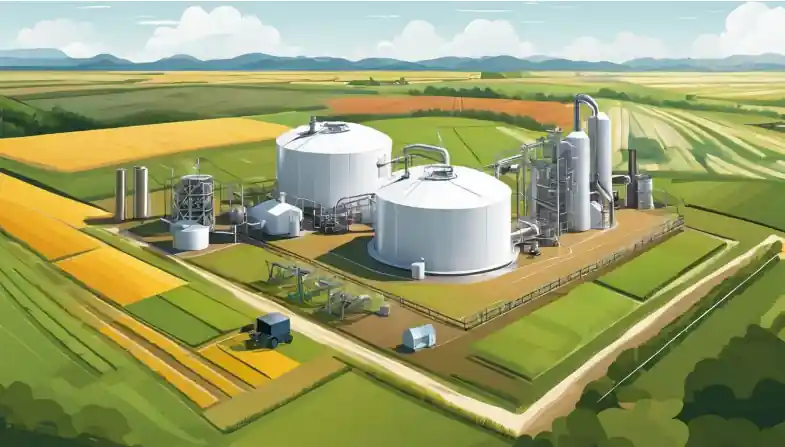
Realising the potential of biomethane in transport
Biomethane could change the way we power our cars and buses. It comes from waste materials, which means it's a smart use of stuff we would otherwise throw away. When this gas replaces diesel or petrol in vehicles, it cuts down on carbon emissions.
That's good news for our planet because less carbon means cleaner air and a step towards Net Zero.
Lorries and buses that run on biomethane are already moving around some cities in the UK. They show us that clean transport works well. At the ADBA National Conference 2021, experts will talk about how to get more of these green vehicles on the roads.
They'll explore how using this gas can make our air nicer to breathe.
More talks at the conference will delve into details like keeping homes warm with green energy and making farms eco-friendly too.
Decarbonising heat, agriculture, and working towards Net Zero
Moving from transport to heating and farming, anaerobic digestion (AD) can help the UK cut carbon even more. Using biogas, we can make heat for homes and businesses cleaner. Farmers can use AD to turn animal waste into renewable energy.
All these changes are big steps towards Net Zero – a future with very little carbon in the air that keeps us all healthy and safe.
Role of AD and green gas in decarbonising heat
When we use AD, less methane goes into the air because it's captured and turned into something useful – energy.
Using biomethane for heating homes and buildings cuts carbon emissions fast. It's part of how the target for net zero UK can be met, by causing fewer carbon emissions from heating by 2050. Some biogas plants already send biomethane to the grid where anyone connected to the gas grid can use it for heat.
This makes a big difference in fighting climate change.
Making biogas helps us reach Net Zero goals whilst managing waste better too..
AD's impact on clean air and new food waste regulations
Expanding on the idea of anaerobic digestion's (AD) impact on producing biomethane and its role in maintaining clean air, especially in Inner City Clean Air Zones, we can explore various facets of this issue:
Biomethane Production through Anaerobic Digestion
- Process Overview: Anaerobic digestion is a process that breaks down organic matter, like agricultural waste, sewage, or food waste, in the absence of oxygen. This process produces biogas, primarily composed of methane and carbon dioxide.
- Biomethane Upgrading: The biogas can be upgraded to biomethane by removing carbon dioxide and other impurities. This upgraded biomethane is similar in quality to natural gas and can be used as a fuel.
Impact on Inner City Clean Air Zones
- Reduction in Air Pollutants:
- Lower NOx Emissions: Biomethane combustion produces lower levels of nitrogen oxides (NOx) compared to diesel fuels. NOx is a significant contributor to air pollution in urban areas.
- Reduced Particulate Matter: Biomethane also emits fewer particulates than traditional fossil fuels. Particulate matter is a key concern in urban air quality, impacting respiratory health.
- CO2 Emissions:
- Carbon Neutral: While burning biomethane does release CO2, it is considered carbon neutral. This is because the CO2 released is roughly equivalent to the CO2 absorbed by the organic matter during its growth phase.
- Supporting Clean Air Policies:
- Compliance with Regulations: Using biomethane in city transport and energy systems can help cities comply with stringent clean air regulations and standards.
- Enabling Low-Emission Zones: Biomethane can power vehicles and facilities in low-emission zones, supporting policies aimed at reducing urban air pollution.
Application in Transportation
- Biomethane for Public Transport: Buses and taxis powered by biomethane offer a clean alternative to diesel engines, significantly reducing urban air pollution.
- Private Vehicles: Adoption of biomethane in private vehicles, though more challenging, could further enhance air quality in urban areas.
Economic and Social Benefits
- Cost-Effective: Biomethane can be a cost-effective fuel option, especially when sourced from local waste materials.
- Job Creation: The AD and biomethane industries create jobs in plant operation, maintenance, and the broader green energy sector.
- Public Health: Improved air quality leads to better public health outcomes, reducing healthcare costs associated with air pollution.
Challenges and Considerations
- Infrastructure Development: Significant investment is needed to develop the infrastructure for biomethane production, distribution, and utilization.
- Supply Consistency: Ensuring a consistent supply of biomethane, especially for transportation, is critical for widespread adoption.
- Public Awareness and Acceptance: Increasing public awareness and acceptance of biomethane as a clean energy source is essential for its success in urban settings.
In summary, the production and utilization of biomethane through anaerobic digestion have a significant potential to contribute to cleaner air in inner city areas. Its application in transportation and energy generation in urban Clean Air Zones can help reduce key pollutants, contributing to both environmental sustainability and public health improvements. However, realizing this potential requires overcoming challenges related to infrastructure, supply, and public perception.
More Funding Sources for Renewable Energy Projects
The UK offers various funding sources for renewable energy projects to support the country's goals for achieving net zero emissions and creating sustainable energy infrastructure. These funding sources are crucial in driving the growth of renewable energy and reducing greenhouse gas emissions.
Environmental researchers, waste management professionals, and government officials should be aware of these opportunities to facilitate the transition to a greener economy.
- The Renewable Energy Investment Fund, managed by the Scottish Investment Bank, provides financial support for eligible renewable energy projects across Scotland, including anaerobic digestion facilities and biogas plants. This fund aims to drive innovation and accelerate the adoption of sustainable energy solutions.
- The Rural Community Energy Fund (RCEF), supported by the Department for Environment, Food & Rural Affairs (Defra) and administered by WRAP, offers grants to rural communities in England for the development of renewable energy projects like biomass and biogas installations. This initiative encourages community-led initiatives that contribute to decarbonising the UK's energy sector.
- Innovate UK runs competitions and offers grants to businesses leading innovative projects in clean growth and sustainable technologies. Funding opportunities under this programme support research and development in areas such as bioenergy, waste management, and low-carbon transportation, aligning with the objectives of delivering net zero emissions.
- The Green Finance Strategy introduced by the UK government outlines initiatives aimed at mobilising investment towards a sustainable and resilient economy. It includes provisions for attracting private capital into green projects through mechanisms like green bonds, ensuring that financing is readily available for renewable energy developments.
- Local authorities across the UK administer schemes such as Low Carbon Infrastructure Transition Programme (LCITP) in Scotland or similar initiatives elsewhere, offering financial assistance for infrastructure projects related to renewable electricity generation, energy efficiency improvements, and sustainable transportation.
- The Industrial Energy Transformation Fund (IETF), overseen by BEIS (Department for Business, Energy & Industrial Strategy), supports industrial decarbonisation projects that involve implementing new technologies to improve energy efficiency or switch from fossil fuels to low-carbon alternatives like biomethane or biogas.
- The European Regional Development Fund (ERDF) provides financial aid for sustainable urban development initiatives including investments in renewable energy infrastructure within eligible regions across England.
Aiming to reduce the UK's greenhouse gas emissions and create green jobs
Through anaerobic digestion and biogas initiatives, tangible steps are being taken to address environmental challenges while fostering economic growth. This focus on sustainability not only benefits the environment but also supports job creation and innovation within the renewable energy sector.
Addressing financial structures is crucial for supporting AD in driving a green recovery that delivers sustainable energy solutions. Within this framework, biomethane plays a pivotal role in decarbonising transport and heat sectors, contributing to both environmental targets and job opportunities.
UK Government and Delivering Net Zero
The UK government is focused on achieving net zero emissions by 2050, aligning with the Climate Change Act of 2008. As part of this commitment, the government aims to reduce greenhouse gas emissions through sustainable energy funding and policies that support renewable energy projects.
Additionally, the government is actively working towards creating green jobs to drive the country's transition to a low-carbon economy.
Net zero UK initiatives like these not only contribute towards reducing greenhouse gas emissions but also play a crucial role in achieving waste reduction targets set out by the UK government and tick many boxes for sustainability.
Net Zero UK FAQs
1. What is anaerobic digestion and how can it help the UK become net zero?
Anaerobic digestion breaks down food waste to make biogas, which helps cut down greenhouse gases, moving the UK towards a net zero goal.
2. Why is biomethane important for achieving net zero?
Biomethane comes from anaerobic digestion and can be used like natural gas. It's cleaner and helps reduce carbon emissions which is key for climate action.
3. Can biogas and biomethane really impact the fight against climate change?
Yes! Biogas cuts down on harmful gases by using waste better, while biomethane offers a greener choice to heat homes without adding bad stuff into the air.
4. How does financing work for projects that use anaerobic digestion?
Money for these projects often comes from green economic plans that support actions good for our planet, like cutting carbon footprints with cleaner energy sources.
5. Do electric cars work well with biogas production in reducing emissions?
Indeed, both electric cars and biogas play big roles in bringing down pollution; they're part of broader changes needed to satisfy carbon budgets set by laws like the Climate Change Act 2008.
6. Is there any connection between sustainable healthcare and anaerobic digestion technology?
Sustainable healthcare tries to limit its effect on Earth, so using clean energy such as biomethane made through anaerobic digestion fits right into this idea.
We have published below the archived ADBA press release for the conference held on this subject in 2021:
Press Release:
ADBA National Conference 2021 to look at how to deliver Net Zero across transport, heat, agriculture and waste management – and find the money for it.
- ADBA National Conference 2021 will take place online on 16th and 17th February
- It will look at the hardest to decarbonise sectors of transport, heat and agriculture, and at the financial structures that can best support AD in the post-Covid Green Recovery
- It will aim to demonstrate the value of AD in achieving Paris Agreement targets ahead of COP26
We are in a decisive decade for decarbonisation, which includes urgently managing organic wastes to prevent the harmful methane emissions they would otherwise emit. This involves treating these resources through anaerobic digestion (‘AD’), the nature-based technology which is able to extract the most value from them – recycling them into green energy and CO2, biofertilisers and other valuable bioproducts.
The AD industry sits at the heart of the circular economy of organic wastes and is ready to deliver on this today. These will be the key messages of next week's ADBA National Conference 2021 hosted by the Anaerobic Digestion and Bioresources Association (ADBA). Entitled “Green gas: ready to go, ready to scale, ready to deliver Net Zero”, the 2021 edition of the annual conference on 16th and 17th February will feature sessions on:
- Realising the potential of biomethane in transport
- The role of AD and green gas in decarbonising heat
- Agriculture and AD – working together for Net Zero
- Digestate – How AD impacts clean air
- The impact of new food waste regulations for AD in the UK
- Financing the Green Recovery in the UK.
“To fulfil AD's potential to reduce the UK's greenhouse gas emissions by 6% over the next decade“, says Charlotte Morton, ADBA's Chief Executive. “it is imperative for the UK government to acknowledge that in AD they have a mature, future-proof technology readily available to help decarbonise key sectors of the economy, in the process creating 60,000 green jobs. Our message to the UK government, months before it hosts COP26, is that AD must be considered in the UK's Net Zero strategy, and the conference will demonstrate why.”
The conference will feature extensive breaks for networking and engaging with the conference sponsors: Air Liquide, Beamex, Clarke Energy, Desotec, Eco2, Flogas, Macquarie, Omex, Target Renewables and Vaisala.
[First posted in February 2021.]

